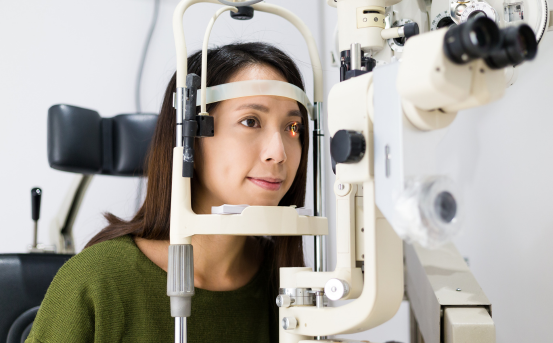Implantable Collamer Lens surgery may be a life-changing option if you’re struggling with high degrees of myopia, hyperopia, or astigmatism and are not an ideal candidate for LASIK or PRK. Before undergoing this advanced vision correction procedure, a thorough and accurate diagnosis is essential to ensure you’re a suitable candidate.
ICL is a cutting-edge, lens-based vision correction procedure that offers long-term results without permanently altering the cornea. It involves placing a biocompatible intraocular lens inside the eye, working in harmony with your natural lens to correct refractive errors. This makes it especially suitable for individuals with thin corneas, dry eyes, or very high prescriptions that fall outside the scope of laser correction methods.
What is Implantable Collamer Lens (ICL) Surgery?
Implantable Collamer Lens surgery is a refractive procedure designed to correct nearsightedness, farsightedness, and astigmatism by implanting a biocompatible lens inside the eye. Unlike LASIK, which reshapes the cornea, the ICL is inserted between the iris and the natural lens without removing any eye tissue. The lens works with your natural lens to improve vision and can be removed or replaced if necessary.
The EVO Visian implantable collamer lens surgery is the most commonly used version and is approved by major regulatory bodies for patients with moderate to severe refractive errors.
Why Proper Diagnosis for Implantable Collamer Lens Surgery Is Crucial?
Proper diagnosis ensures that :-
-
Your eye structure is suitable for lens implantation
-
The correct lens size and power are selected
-
Potential risks or contraindications are identified
-
You have realistic expectations for post-surgical outcomes
Skipping detailed diagnostics can lead to complications such as high intraocular pressure, lens misalignment, or cataract formation.
Diagnostic Process for ICL Surgery
Let’s walk through the standard diagnostic process that ophthalmologists follow before approving a patient for ICL surgery.
Comprehensive Eye Examination
The first and most important step is a detailed eye exam performed by a refractive surgeon or ophthalmologist. This includes :-
-
Visual acuity test :- Measures your ability to see at various distances with and without corrective lenses.
-
Refraction test :- Determines the exact degree of myopia, hyperopia, or astigmatism.
The results help confirm if your refractive error is within the approved range for ICL surgery.
Corneal Topography and Pachymetry
While implantable collamer lens surgery does not reshape the cornea like LASIK, it’s still important to assess your corneal health and thickness.
-
Corneal topography maps the shape and curvature of your cornea to rule out conditions like keratoconus.
-
Pachymetry measures corneal thickness, which is essential if LASIK has been previously considered or performed.
Even though ICL is cornea-sparing, abnormalities in these areas may indicate other ocular issues that need management before surgery.
Anterior Chamber Depth (ACD)
A key diagnostic metric for ICL surgery is the Anterior Chamber Depth (ACD) the space between the cornea and the natural lens.
The recommended minimum ACD is usually 2.8 mm or more, depending on the ICL model. This space ensures the lens can be safely placed without touching other eye structures and causing damage.
Measurements are usually taken via ultrasound biomicroscopy or optical coherence tomography (OCT).
White-to-White (WTW) and Sulcus-to-Sulcus (STS) Measurements
To select the correct size of the implantable lens, surgeons measure :-
-
White-to-White (WTW) :- Horizontal diameter of the visible iris
-
Sulcus-to-Sulcus (STS) :- Internal diameter from one ciliary sulcus to the other
Correct sizing is crucial for preventing lens rotation or dislocation, especially in patients with astigmatism using toric ICLs.
Endothelial Cell Count
The endothelial cells line the back of the cornea and help maintain corneal clarity by pumping out excess fluid. ICL placement in the eye could affect these cells if not properly accounted for.
A specular microscopy test checks the endothelial cell density (ECD). A low count may disqualify a patient from ICL surgery to avoid corneal decompensation later.
Intraocular Pressure (IOP) Test
A tonometry test is conducted to measure your intraocular pressure. Elevated IOP may signal glaucoma or a predisposition to it, which must be addressed before surgery.
Some patients may require a pre-ICL peripheral iridotomy or laser iridotomy to prevent post-operative pressure spikes, although newer ICL models like EVO Visian often eliminate this need.
Retinal Examination
A dilated retinal exam is essential for people with high myopia, as they’re at a higher risk for retinal thinning, holes, or detachment.
The surgeon will evaluate :-
-
Macular health
-
Presence of retinal tears
-
Signs of degeneration
If any abnormalities are found, retinal treatment may be required before ICL surgery.
Medical and Ocular History Review
Your eye doctor will assess :-
-
Past ocular surgeries (e.g., LASIK, PRK, cataract surgery)
-
Systemic conditions (e.g., diabetes, autoimmune disorders)
-
Any medications affecting eye pressure or vision
These factors influence your eligibility and recovery timeline.
Who Is an Ideal Candidate for ICL Surgery?
Based on the diagnostic results, ideal candidates typically :-
-
Are between 21 and 45 years old
-
Have stable vision for at least a year
-
Have moderate to severe myopia (typically -3.00 D to -20.00 D)
-
Do not have significant dry eye syndrome or keratoconus
-
Have sufficient anterior chamber depth and healthy endothelial cells
-
Are not pregnant or nursing
When Is ICL Surgery Not Recommended?
ICL surgery may not be suitable if :-
-
You have uncontrolled glaucoma
-
Your endothelial cell count is too low
-
The anterior chamber is too shallow
-
You have active eye infections or inflammation
-
You’re under 21 or your prescription is unstable
What Happens After the Diagnosis?
If you’re deemed a good candidate :-
-
Your lens size and power will be ordered
-
You may be prescribed pre-surgery eye drops
-
The surgeon will walk you through risks, benefits, and recovery
The implantable collamer lens surgery procedure is typically performed under local anesthesia, and most patients experience significantly improved vision within 24–48 hours.
Conclusion
A precise and in-depth diagnostic process for implantable collamer lens surgery is not just a formality it’s a safety net that ensures long-term visual success. From evaluating corneal health to measuring the anterior chamber depth and endothelial cell count, each step plays a vital role in determining your candidacy and customizing your treatment.























